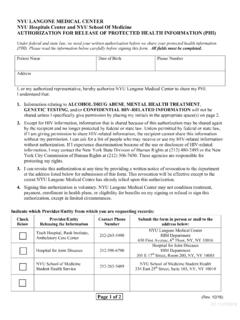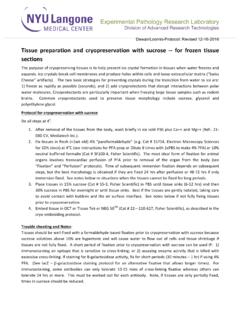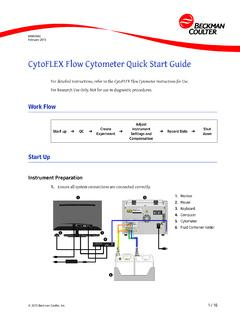Transcription of GENETIC MODIFICATION: THE ETHICAL AND SOCIETAL ...
1 NYU SCHOOL OF MEDICINE HIGH SCHOOL BIOETHICS PROJECT GENETIC modification : THE ETHICAL AND SOCIETAL IMPLICATIONS OF CRISPR technology OVERVIEW This module aims to build an understanding of the moral and ETHICAL implications of GENETIC modification , specifically regarding the use of CRISPR technology for germline (heritable) and somatic (non heritable) GENETIC editing. The module will incorporate a study of recent scientific discoveries, breakthroughs, and controversies through ETHICAL and conceptual lenses. While CRISPR has a variety of potential applications, this module explores the GENETIC modification of human DNA and the consequences of these edits.
2 CRISPR is a technology adapted from a naturally occurring genome editing system in bacteria that is a more accurate, effective, and cost efficient way to alter DNA than techniques used previously. It allows geneticists and medical researchers to edit parts of the genome by removing, adding, or altering parts of the DNA sequence. What is CRISPR and how does it work? Why have scientists currently called for a moratorium on the clinical use of CRISPR for germline modification ? What is the future of CRISPR, how will it be regulated, and how will it affect the world in which we live?
3 This module will delve into these questions and leave the classroom with a newfound understanding of the ETHICAL implications behind the use of this technology . CONTENTS 1. Key Terms2. Introduction to the Topic3. Goals and Applications of with the Technology5. ETHICAL Concerns6. Recent Developments7. References and Additional Resources8. Concluding AssignmentLEARNING OUTCOMES a solid understanding of how CRISPR technology the difference between germline andsomatic able to participate in thoughtfuldiscussions regarding the ETHICAL concernsof GENETIC to a conclusion about how CRISPR technology should be regulated AND ACTIVITIES This module is a student led exploration of the world of GENETIC modification with a specific focus on germline modification and the recent developments in the scientific community.
4 Students will participate in discussion and group activities in order to better their understanding of the material and incorporate the viewpoints of others into their own thinking. 1 DC 1/27/20201. KEY TERMSC ells are the basic building blocks of all living things. The human body is composed of trillions of cells. They provide structure for the body, take in nutrients from food, convert those nutrients into energy, and carry out specialized functions. Cells also contain the body s hereditary material and can make copies of themselves. DNA, or deoxyribonucleic acid, is the hereditary material in humans and almost all other organisms.
5 Almost every cell in a person s body has the same DNA. Most DNA is located in the cell nucleus (nuclear DNA) while a small amount of DNA can be found in the mitochondria (mitochondrial DNA or mtDNA). The information in DNA is stored as a code made up of four chemical bases: Adenine (A) Guanine (G) Cytosine (C) Thymine (T) Human DNA consists of approximately 3 billion bases, 99 percent of which are the same in all people. The specific order of these bases determines the information available for building and maintaining an organism. DNA bases pair up with each other, A with T and C with G to form units called base pairs.
6 Genes are the functional and physical units of heredity passed from parent to offspring. Genes are pieces of DNA that can vary in size from a few hundred DNA bases to more than 2 million bases. Every person has two copies of each gene, one inherited from each parent. Most genes code for a specific protein or segment of protein leading to a particular characteristic or Genome is an organism s complete set of DNA, including all of its genes. Each genome contains all of the information needed to build and maintain that organism Genotype refers to the GENETIC makeup of an organism.
7 It describes an organism's complete set of genes. The term can be used to refer to the alleles, or variant forms of a gene, that are carried by an organism. Phenotype refers to the observable physical properties of an organism; these include the organism's appearance, development, and behavior. An organism's phenotype is determined by its genotype, which is the set of genes the organism carries, as well as by environmental influences upon these genes. Nucleotides are made up of a base, sugar, and phosphate. Each base is attached to a sugar molecule and a phosphate molecule.
8 Nucleotides are arranged in two long strands that form a DNA spiral called a double helix. The structure of the double helix is somewhat like a ladder, with the base pairs forming the ladder s rungs and the sugar and phosphate molecules forming the vertical side pieces of the ladder. RNA is the DNA photocopy of the cell. When the cell needs to produce a certain protein, it activates the protein s gene and produces multiple copies of that piece of DNA in the form of messenger RNA, or mRNA. The multiple copies of mRNA are then used to translate the GENETIC code into protein through the action of the cell s protein manufacturing machinery, the ribosomes.
9 2 DC 1/27/2020 Gene poolis the sum of a population s GENETIC material at a given time. Typically used in reference to apopulation made up of individuals of the same species and includes all genes and combinations of genes inthe population. Sum of a population s GENETIC material at a given , allelomorph, are any one of two or more genes that may occur alternatively at a given site or locus ona chromosome. They may occur in pairs or there may be multiple alleles affecting the expression of a particulartrait. Most traits are determined by more than two alleles and all GENETIC traits are the result of the interactionsof Chromosomeis the microscopic threadlike part of the cell that carries hereditary information in the form ofgenes.
10 46 chromosomes in 23 pairs are found in each human is the selection of desired heritable characteristics in order to improve future generations, typically inreference to humans. The term eugenics was coined in 1883 by British explorer and natural scientist FrancisGalton, who, influenced by Charles Darwin s theory of natural selection, advocated a system that would allow the more suitable races or strains of blood a better chance of prevailing speedily over the less suitable. A Mutationis an alteration in the GENETIC material (genome) of a cell of a living organism or of a virus that ismore or less permanent and that can be transmitted to the cell s or the virus s descendantsA Germline mutationis an alteration in the GENETIC constitution of the reproductive cells, occuring in the celldivisions that result in sperm and eggs.









